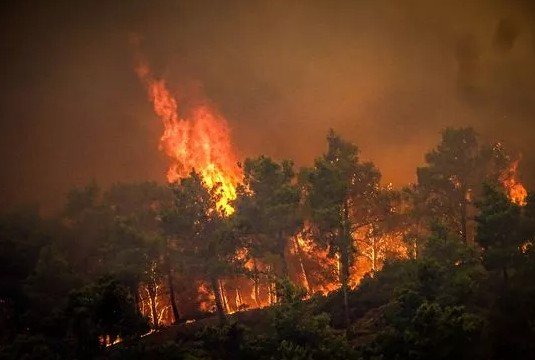
When the Sky Turns to Dust: Israel Battles Sandstorms, Wildfires, and Climate Extremes on Its Independence Day
- Breaking NewsCrime/MishappeningHEADLINESNATION
- May 1, 2025
- No Comment
- 32
As Israel prepared to mark its 77th Independence Day, nature unleashed a harrowing reminder of the climate volatility sweeping across the globe. A severe sandstorm, propelled by fierce winds, swept through the southern desert regions of Israel on Wednesday, plunging the Negev Desert and the city of Beersheba into a surreal haze of amber skies and choking dust. Social media was flooded with videos of dust clouds so dense they turned daylight into a sepia-toned blur, reducing visibility to near zero and prompting a cascade of emergency responses.
The sandstorm, driven by scorching winds from the Arabian desert, struck with an almost cinematic ferocity. In one widely circulated video, Israeli soldiers could be seen struggling to secure the gates of a military base in the Negev, battling gusts powerful enough to destabilize routine operations. Meteorologists had warned of the impending weather event, forecasting a wave of extreme heat accompanied by sandstorms in the south. Temperatures soared to 100 degrees Fahrenheit (about 38°C) along Israel’s coastal regions, exacerbating the already volatile conditions.
This year’s Independence Day, typically a moment of national pride and celebration, instead became a test of resilience. In an unprecedented move, the Israeli government cancelled the live broadcast of its flagship ceremony, opting instead to air a pre-recorded version. The decision underscored the seriousness of the weather situation, which not only disrupted national events but also threatened lives and livelihoods across the country.
As if the sandstorm were not enough, Israel was simultaneously grappling with another crisis — wildfires on the outskirts of Jerusalem. The fires, intensified by dry air and heavy winds, swept through forested hills near the capital. Emergency services scrambled to respond as thick smoke engulfed key roadways, including the main Route 1 highway that connects Jerusalem to Tel Aviv. Dramatic TV footage showed residents abandoning their vehicles and fleeing on foot as flames licked the edges of the road and smoke turned the hillsides into a smoldering blur.
Three communities were evacuated as a precaution, with at least 13 people injured in the chaos. Fortunately, no fatalities were reported. The timing could not have been more poignant — the fires erupted during Yom HaZikaron, Israel’s Memorial Day for fallen soldiers, when many people gather to honor the country’s dead. Numerous ceremonies were cancelled, including the solemn state event planned for Jerusalem, as the government pivoted its attention to managing the twin disasters.
Prime Minister Benjamin Netanyahu confirmed that Israel had appealed for international assistance. Italy and Croatia were among the first to respond, pledging to send firefighting aircraft to help contain the blazes. Appeals were also extended to Greece, Cyprus, and Bulgaria. On the ground, over 120 fire and rescue units, backed by the Israeli military, deployed helicopters and aircraft in an effort to bring the situation under control.
For climate experts and environmental observers, the dual crisis — sandstorm and wildfire — is yet another stark illustration of the increasing unpredictability and extremity of weather events across the Mediterranean and Middle East regions. Israel, a country with vast desert expanses and densely populated urban centers, is especially vulnerable to shifts in climate patterns. According to recent UN climate reports, the Middle East is warming at nearly twice the global average, with prolonged droughts, record-breaking heatwaves, and desertification becoming increasingly frequent.
These compounding emergencies are also testing the resilience of Israel’s infrastructure and civil preparedness. While the nation has historically excelled in emergency response and defense logistics, climate-induced disasters present a new frontier of challenges — ones that transcend borders, politics, and even ideology.
As the country now turns to the somber task of damage control and recovery, the real question echoes far beyond Israel’s borders: how many more warnings from nature will it take before the world reckons with the realities of a warming planet?
This article is based on publicly available information and intends to provide a comprehensive account of current events related to extreme weather in Israel.
#ClimateCrisis #IsraelSandstorm #JerusalemFires #ExtremeWeather #MiddleEastHeatwave



